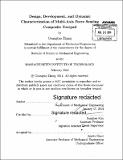| dc.contributor.advisor | Sangbae Kim. | en_US |
| dc.contributor.author | Zhang, Guangtao, S.B. Massachusetts Institute of Technology | en_US |
| dc.contributor.other | Massachusetts Institute of Technology. Department of Mechanical Engineering. | en_US |
| dc.date.accessioned | 2015-01-05T20:05:52Z | |
| dc.date.available | 2015-01-05T20:05:52Z | |
| dc.date.copyright | 2014 | en_US |
| dc.date.issued | 2014 | en_US |
| dc.identifier.uri | http://hdl.handle.net/1721.1/92686 | |
| dc.description | Thesis: S.B., Massachusetts Institute of Technology, Department of Mechanical Engineering, 2014. | en_US |
| dc.description | Cataloged from PDF version of thesis. | en_US |
| dc.description | Includes bibliographical references (pages 79-80). | en_US |
| dc.description.abstract | Accurate ground reaction force measurements are important for the development, implementation, and control of high speed legged locomotion robots. From previous research studies, a composite force sensing footpad has been developed, tested, and characterized statically at the MIT Biomimetics Lab. The developed footpad sensor must also be characterized dynamically prior to its implementation with the MIT Cheetah robot. This study includes the design, development, and dynamic characterization of the footpad sensor. In order to characterize the developed footpad sensor dynamically, a custom impact tester has been designed, fabricated, characterized, and verified. The developed impact tester was shown to satisfy all the specified functional requirements and is capable of producing a range of impact conditions to cover the possible operational modes of the MIT Cheetah robot such as running, walking, galloping, or hopping. The previously developed static ANN model was shown to be highly imprecise and a dynamic ANN model was developed to better predicate the force profile during impact. The dynamic ANN model was shown to perform 400% better at predicting peak impact force.It was also verified with additional dynamic testings of the footpad sensor, and RMSE = 3.17% for a maximum reference force reading of 3000N was achieved for the developed dynamic ANN model. The footpad sensor was redesigned and fabricated to integrate with the MIT Cheetah robot. Numerous Cheetah robot hopping experiments were carried out, and the footpad sensor was able to detect ground contact accurately and precisely. 'No damage nor performance degrading of the developed footpad sensor was observed at the end of the experimentation. Though further testing and optimization of the composite footpad sensor is required, the developed prototype has shown promising results under both static and dynamic conditions, which suggests that a composite footpad force sensor is not only a viable approach for force sensing but also likely to take place of the rigid force sensing devices in the high speed locomotion robots' arena. | en_US |
| dc.description.statementofresponsibility | by Guangtao Zhang. | en_US |
| dc.format.extent | 91 pages | en_US |
| dc.language.iso | eng | en_US |
| dc.publisher | Massachusetts Institute of Technology | en_US |
| dc.rights | M.I.T. theses are protected by copyright. They may be viewed from this source for any purpose, but reproduction or distribution in any format is prohibited without written permission. See provided URL for inquiries about permission. | en_US |
| dc.rights.uri | http://dspace.mit.edu/handle/1721.1/7582 | en_US |
| dc.subject | Mechanical Engineering. | en_US |
| dc.title | Design, development, and dynamic characterization of multi-axis force sensing composite footpad | en_US |
| dc.type | Thesis | en_US |
| dc.description.degree | S.B. | en_US |
| dc.contributor.department | Massachusetts Institute of Technology. Department of Mechanical Engineering | |
| dc.identifier.oclc | 898212018 | en_US |
